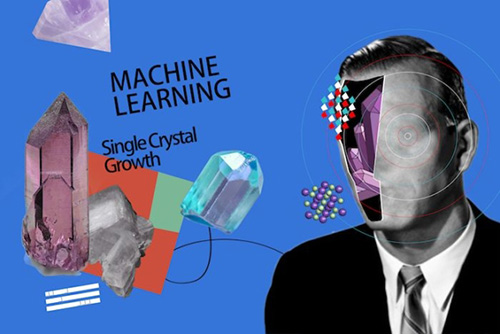Growing better single crystals with the help of machine learning
Date:06-06-2019 Print

Courtesy: Yu-Jie Sun
Machine learning could help grow high-quality single crystals by predicting whether a particular crystal can be successfully grown under given experimental conditions. The approach could be an inexpensive and rapid alternative to growing crystals in the laboratory.
Machine learning (ML) is the process by which a system learns from a training set so that it can autonomously deliver an appropriate response when supplied with new data. Although pioneered in the middle of the 20thcentury, increasingly powerful computers and faster calculations speeds mean that ML is now being applied to solve problems in areas as diverse as finance, healthcare, transport and, of course, science.
Single crystals are crucial for many research fields, including condensed matter physics, surface science, lasers and nonlinear optics. Fundamental studies, such as those on the quantum Hall effect and Wyle semi-metals, to name just two examples, all require high-quality single crystals.
It is difficult to grow single crystals in the laboratory, however, because so many interrelated factors, such as temperature and material composition ratios, need to be considered. Growing ternary compounds is particularly problematic because of the lack of ternary phase diagrams. Single crystal growth is thus labour-intensive and time consuming.
ML could come into its own here, say researchers at the Chinese Academy of Sciences in Beijing, and Renmin University, also in Beijing, who have focused on the single-crystal growth of ternary compounds by the so-called flux method, which is one of the most widely used methods in laboratories to grow crystals.
Data on crystal growth used to train ML
In their study, the researchers collected data on crystal growth from two different groups in their laboratory. This data includes growth temperature curves, raw elemental compositions and ratios, and growth conditions. Both the quantity and quality of the data is important for generating successful models, they say. Issues like the presence of noise and outliers, missing, inconsistent or duplicate data, and data that are biased or unrepresentative of the phenomena at hand, thus need to be taken into account.
The team trained four kinds of ML (support vector machine, or SVM, decision tree, random forest and gradient boosting decision tree) on the experimental data. The SVM method works well and can predict with an accuracy of 81% which crystals will grow under specific, artificially selected, growth conditions. To compare, this figure is just 36% for crystal growth experiments in the laboratory. The decision tree model, for its part, reveals which features are critical in a particular growth process.
"We use the model obtained by the decision tree on the training data to analyse the important factors of single crystal growth," explains team member Yu-Jie Sun. "Based on the information obtained, we then use the SVM to predict whether the growth conditions selected can successfully guide crystal growth in the laboratory."
Accuracy will continue to improve
"The accuracy of the technique will continue to improve as we increase the amount of laboratory data we use to train the ML," he adds. "We adjust the weight of different new data when adding this to the training model.
"Our work shows that such a learning model can predict and instruct crystal growth in the laboratory," he tells Physics World. "The approach could help grow high-quality crystals more efficiently, further automate the process and so promote the development of the disciplines that rely on single crystals."
The researchers, reporting their work in Chinese Physics Letters10.1088/0256-307X/36/6/068101, are now trying to broaden the scope of their technique. "At present, our research is quite limited, so we are going to try new learning algorithms, grow more kinds of single crystals and look into other growth methods and larger databases," says Sun. "We hope that our method will be able to not only predict growth conditions, but also the appropriate growth method for any type of single crystal." (Physics World)

